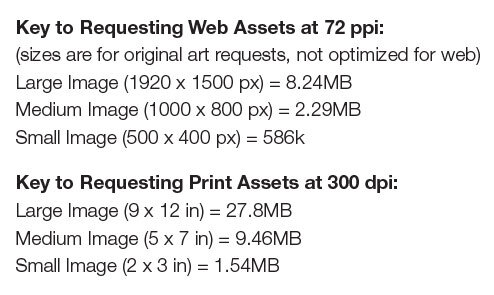We've all been there - we ask clients for photo or logo assets and they'll send us a tiny 40K image for a print layout or ask us to just grab it off the web. We must explain that such moves won't work because the image resolution is too low. Let's take a closer look at why that is.
An image's resolution refers to the density of the pixels (or printed dots) that constitute it. At high resolutions, the image is crisp and vividly detailed. If the resolution is decreased or the image is blown up too much, it loses detail and the blocky squares of the pixels become noticeable.
Screen resolution is measured in PPI (pixels per inch) and print resolution is measured in DPI (dots per inch). Because a computer monitor is made up of pixels of a fixed resolution (72 ppi) any image optimized for that resolution looks fully detailed and natural to the human eye on screen.
If that same image is printed on a press or copier, its inherent pixel "blockiness" becomes visible, as well as the unsightly effects of image compression (like distortion around edges).
For professional print graphics, 300 dpi is standard. If you want to use a web-sized image in print, there's no way to magically generate extra pixels and make a beautiful brochure cover image. A graphic designer may be able to up-size a low-resolution web image slightly, but it will be small and look blurry.
When you have a choice of image sizes at your disposal, such as from an in-house image library or stock photo site, it's best to go for the largest image you can get. Any image can be made smaller as needed, but it can't be sized up without losing quality. When it comes to resolution, bigger really is better! Another element to c
onsider when dealing with image quality is whether the file is in a raster or vector format.
A raster image is made of hundreds (or thousands or millions) of tiny squares of color information, referred to as pixels. What is the most common type of raster graphic? A photograph, although graphics and logos will be saved in this format for use in digital applications. The designer's preferred program for creating and editing raster files? You guessed it: Adobe Photoshop. Popular raster file format extensions include: .jpg/.jpeg, .psd, .png, .tif, .bmp, and .gif.
The pros of a raster image lie in its ability to accommodate rich detail: Your (1 x 1 in) square image at 300 dpi has 300 individual squares of color that provide precise shading and detail in your image. The more dpi your image contains, the more subtle details will be noticeable. This is great for photos and continuous tone graphics! Precise Editing: All those individual pixels of color information can also be modified, one by one. So, if you're a true perfectionist, the level of editing and customization available in a raster image is almost limitless.
The biggest downfall to raster images is that they become pixelated (aka grainy) when enlarged. They are not the best for text and hard-edged graphics. Remember how a (1 x 1 in) square at 300 dpi will have 300 individual points of color information for the computer to remember? Well, let's say you have an (18 x 24 in) photo - that is 129,600 bits of info for a computer to process - which can quickly slow down even the fastest machine.
A vector graphic uses math to draw shapes using points, lines, and curves. So, whereas a raster image of a (1 x 1 in) square at 300 dpi will have 300 individual pieces of information, a vector image will only contain four points, one for each corner; the computer will use math to "connect the dots" and fill in all the missing information. The most common types of vector images are fonts, logos, and graphics. The designer's preferred program for creating and editing vector files is Adobe Illustrator.
When requesting a logo file from a client, getting a vector graphic is always the best option. Raster files can be exported from the vector file. Think of the vector file as the mother of all logo files. Popular vector file format extensions include: .ai, .eps, .pdf, and .svg.
When in doubt, don't be afraid to reach out for help or clarification. LKF Marketing is happy to provide guidance on general practices or specific needs.


